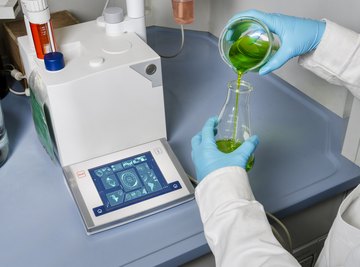
Density (D) is a quantity defined as mass (m) per unit volume (v): D = m ÷ v. Since these three quantities are related, you can find one of them if you know the other two. This is more helpful than it sounds because density is often a known quantity that you can look up, assuming you know the composition of the material.
Calculations are straightforward for solid objects, but things get more complicated for liquids, where density changes with temperature, and for gases, for which density is dependent on temperature and pressure.
Use Consistent Units
The equation relating density, mass and volume is straightforward and allows you to calculate the density of a material if you measure its mass and volume. The only caveat is that you have to make the measurements in the same system.
For example, if you measure mass in kilograms, you should measure volume in cubic meters, and if you measure volume in quarts, you should measure mass in pounds. The three systems you're likely to use are CGS (centimeters, grams, seconds), MKS, (meters, kilograms, seconds) and British Imperial. The most-used units for densities in these three systems are:
- CGS: grams/cubic centimeter or grams/milliliter
- MKS: kilograms/cubic meter
- British: pounds/cubic foot
Using the Density, Mass and Volume Calculator
Example: Suppose you have a beaker full of a mystery aqueous solution. Calculating its density and comparing it to that of pure water can help determine its composition.
You calculate the volume of the solution by measuring the dimensions of the beaker and the level of the liquid and find it to be 355 ml. Since a milliliter is a cubic centimeter, you should find the mass in grams. You find that it's 372 gm.
The density is then 372 gm ÷ 355 ml = 1.05 gm/ml. That's just a little denser than pure water (1 gm/ml), so whatever is dissolved in the water is at a low concentration.
Example: You find a large rock with a roughly spherical shape and want to know its composition. Finding its density can help you determine that.
Calculate the volume of the rock by measuring its diameter and dividing by 2 to find its radius (r).
The volume of a sphere is 4/3πr3, so if the rock has a radius of 10 inches, its volume is 418.67 cubic inches.
Convert to cubic feet by multiplying by 0.00057. The result is 0.239 cubic feet.
If the rock weighs 40 pounds, its density is 40 lb/0.239 ft3 = 167. 36 lb/ft3. This is very close to the density of granite, so there's a good chance the rock is solid granite.
Using Density Tables
If you have an object made of a known material, you can look up its density in a table. This information allows you to calculate its volume by weighing it. If you already know its volume, you can calculate its mass. Using the density, mass, volume calculator just requires rearranging the density equation to express the parameter you want in terms of the other two.
Example: Suppose you have a gold statue, and you want to find its volume.
D = m ÷ v, so v = m ÷ D
You find the statue weighs 2 kg. In a table, you'll find the density of gold to be about 19,300 kg/m3.
Plugging in numbers, you find the volume to be 2 kg ÷ 19,300 kg/m3 = 0.0001 m3 or about a tenth of a liter.
Example: How much does a milliliter of mercury weigh?
D = m ÷ v, so m = Dv
The density of mercury is 13.6 g/ml, so a volume of 1 ml has a mass of 13.6 grams.
References
Tips
- The ^ symbol is used to indicate "raised to," so when a formula reads n^3, it is that number "n" cubed or raised to the third power (n*n*n).
About the Author
Chris Deziel holds a Bachelor's degree in physics and a Master's degree in Humanities, He has taught science, math and English at the university level, both in his native Canada and in Japan. He began writing online in 2010, offering information in scientific, cultural and practical topics. His writing covers science, math and home improvement and design, as well as religion and the oriental healing arts.
